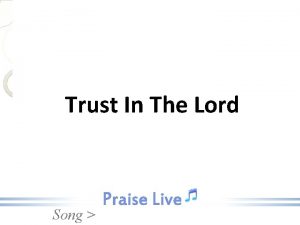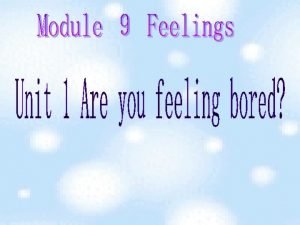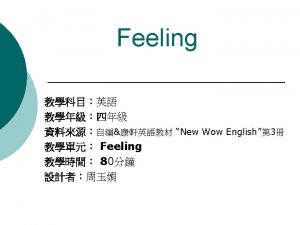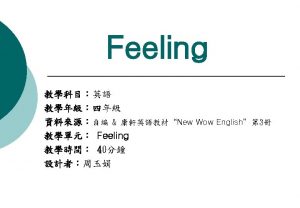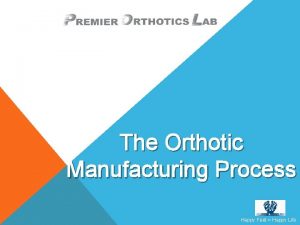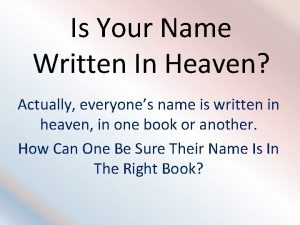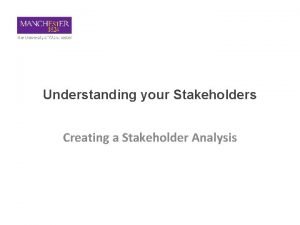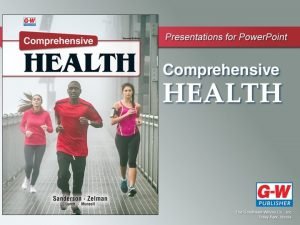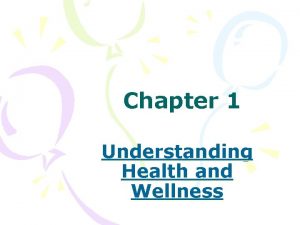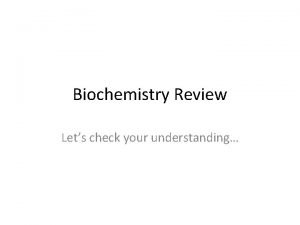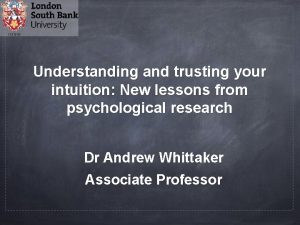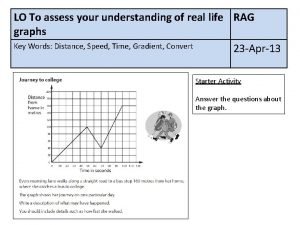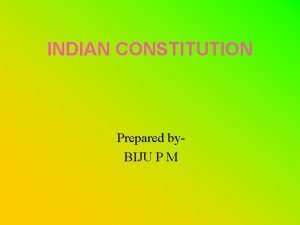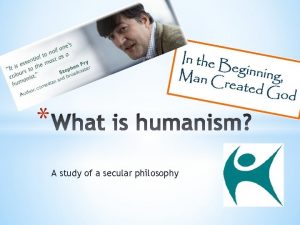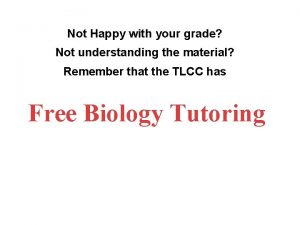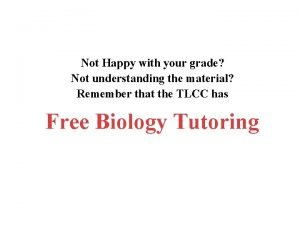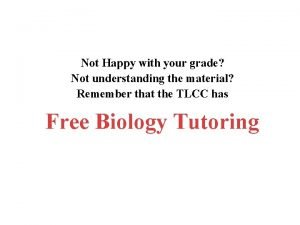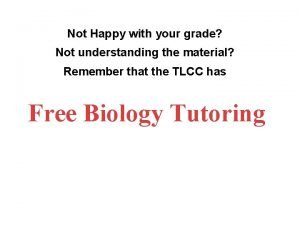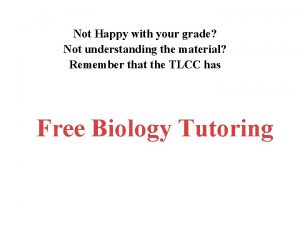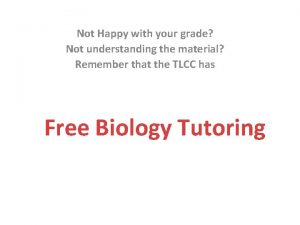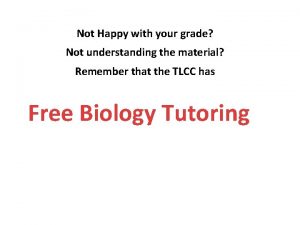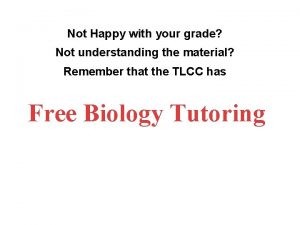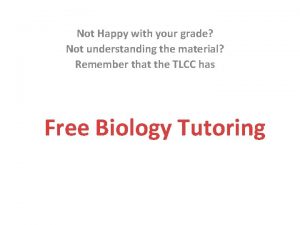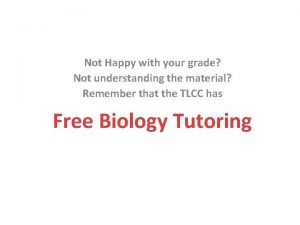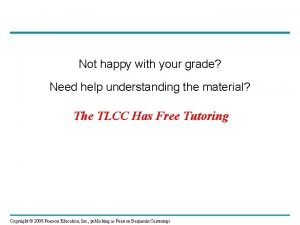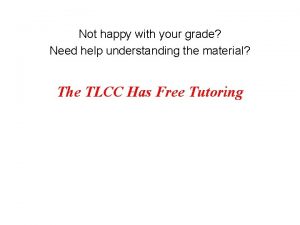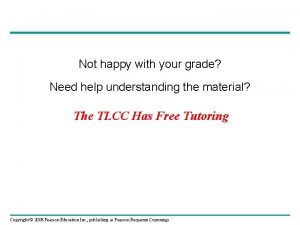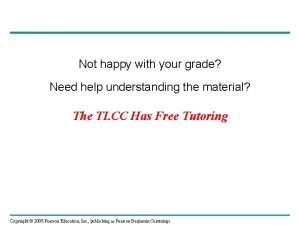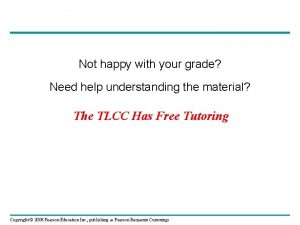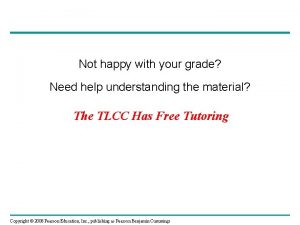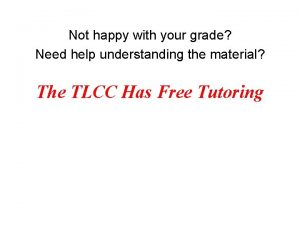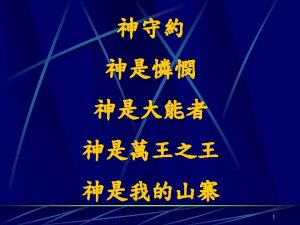Not Happy with your grade Not understanding the

























































- Slides: 57

Not Happy with your grade? Not understanding the material? Remember that the TLCC has Free Biology Tutoring

Chapter 9 Photosynthesis and Respiration

Photosynthesis & respiration • most ecosystems based on photosynthesis • Photosynthesizers are producers • Everything else is a consumers • “Metabolism” – reactions to capture, store and use energy


Energy: two major paths • Photosynthesis • Cellular Respiration • Most producers (autotrophs) do both • Most consumers (Heterotrophs) don’t use photosynthesis • BOTH USE AN ELECTRON TRANSPORT CHAIN

Producers (autotrophs) • Take energy from the environment Chemosynthesis Photosynthesis = uses light to make sugar (G 3 P) • Photosynthesis: Inputs CO 2, H 2 O, light Outputs Sugars and oxygen • Use own sugars for respiration Eukaryotes use mitochondria for respiration

Molecular Energy Carriers: ATP Adenosine triphosphate (ATP) ATP is the main energy source of cell • Requires energy – Photosynthesis – Respiration

Molecular Energy Carriers • ATP (used for MANY types of reactions) • NADPH (some energy for anabolic reactions) • NADH (absorbs energy released in catabolic)

NADPH & NADH – NADPH: electrons & hydrogen to anabolic react. – NADH: picks up electrons and hydrogen released from catabolic reactions

Light: energy to make Carbohydrates • Chloroplast – Eukaryote organelles for photosynthesis • Have chlorophyll to absorb light energy Light reactions – make energy molecules Calvin cycle – make sugars

Photosynthesis: Two Stages Photosynthesis stages: 1. Light reactions Use light energy to make ATP, NADPH, and break water broken water molecules: source of oxygen 2. Calvin cycle CO 2 sugar using energy from ATP and NADPH Entire ecosystem depends on this sugar!!!


Leaves • Stomata – how plants “breath” Take in CO 2, release O 2 (opposite of respiration) • Many cells full of Chloroplasts Photosynthesis organelle Calvin Cycle (sugar production) happens here

Chloroplasts • Light reactions in Thylacoids • The Calvin cycle (CO 2 sugar) in stroma


Chloroplast: Light Reactions • Light-absorbing molecules in thylakoid membrane collect energy from sunlight • Absorbed light “excites” electrons (higher energy) • Chloroplast ETC plays “hot potato” with electron • Uses energy to move protons (hydrogen ions)

Chloroplast: Light Reactions Thylacoid membranes full of hydrogen ions From splitting water From chloroplast electron transport chain

Making ATP : movment of H+ ions Thylacoid membranes full of hydrogen ions H+ wants to move: high concentration low H+ movement = energy (like water wheel) The movment of hydrogen ions powers the production of ATP (“ATP synthesis”) and NADPH


Making Oxygen: byproduct Splitting water frees Oxygen Two broken H 20 molecules Two free oxygens combine O + O O 2 Oxygen Gas Needed for all life on earth!!!

Chloroplasts • Light reactions in Thylacoids • The Calvin cycle (CO 2 sugar) in stroma

Calvin Cycle: making sugars • Happens in Stroma • Uses carbon dioxide from air “carbon fixation” • Makes a three carbon sugar glyceraldehyde 3 -phosphate (G 3 P) • Depends on an enzyme nickname “Rubisco”

Calvin Cycle: making sugars • Calvin Cycle needs energy • Fixes one carbon each cycle 3 cycles to make each 3 carbon sugar (G 3 P) • G 3 P is the building block of all carbohydrates


G 3 P: building block of sugars • G 3 P is the building block of glucose and all the other carbohydrates • Leaves chloroplast, fuel chemical reactions • In plants, G 3 P can be stored as starch for use at night

Photosynthesis: Two Stages Photosynthesis stages: 1. Light reactions Use light energy to make ATP, NADPH, and break water broken water molecules: source of oxygen 2. Calvin cycle CO 2 sugar using energy from ATP and NADPH Entire ecosystem depends on this sugar!!!

Cellular Respiration: Sugar ATP • Cellular respiration requires oxygen to break down food molecules • The energy released from the food molecules is used to generate ATP • Carbon dioxide and water are by-products of cellular respiration

Cellular Respiration: Sugar ATP • Getting ATP from food molecules • Three Stages 1. Glycolysis 2. Kreb cycle – requires oxygen 3. “oxidative phosphoryation”– requires oxygen Electron transport chain • By-products: CO 2 and water

Cellular Respiration: Sugar ATP • Three Stages 1. Glycolysis – in cytosol 2. Kreb cycle – in mitochondria 3. “oxidative phosphoryation”– in mitochondria Electron transport chain


Cellular Respiration: Energy from Food • Both producers and consumers do Cellular Respiration • Three main stages of cellular respiration: – Glycolysis – The Krebs cycle – Oxidative phosphorylation (electron transport chain)

Glycolysis • 1 st part of cellular metabolism • “Glyco”(glucose) + “lyse”(break) = breaking glucose • Happens in cytosol Outside Mitochondria • 6 -carbon glucose 3 -carbon pyruvate

Glycolysis: Cellular Metabolism (part 1) • Uses 2 ATP • Makes 4 ATP – Net gain of 2 • Makes 2 NADH • Pyruvate then enters the mitochondria for steps two and three, during which it is broken down


We need LOTS of ATP • Glycolysis No O 2 used doesn’t make enough ATP (>1/4 total) exception: some bacteria and fungi (yeast) • Two more steps in Cellular Respiration Kreb Cycle – Needs O 2 “Oxidative phosphorylation” – needs O 2

Krebs Cycle: Cellular Metabolism (part 2) • “aerobic” – uses oxygen • Happens in mitochondria • Lots of mitochondria in muscle • Lots of energy for muscle • Requires lots of blood flow (oxygen for mitochondria)

Krebs Cycle: Cellular Metabolism (part 2) • Pyruvate into mitochondria output (product) from glycolysis will be used as input (reactant) for Krebs must be modified first!!! • • Pyruvate acetyl Co. A (requires oxygen) • Krebs (a. k. a. “Citric Acid Cycle”) makes ENERGY a little ATP a LOT of NADH a little FADH 2,

Krebs Cycle: Cellular Metabolism (part 2) • Pyruvate acetyl Co. A (requires oxygen) • Krebs (a. k. a. “Citric Acid Cycle”) makes ENERGY a little ATP, LOTS of NADH, a little FADH 2,

Krebs Cycle: Cellular Metabolism (part 2) Krebs Releases Carbon Dioxide (why we exhale CO 2) energy molecules from Krebs: Why NADH & FADH 2? (NEVER WASTE ENERGY) , NADH, FADH 2

Krebs Cycle: Cellular Metabolism (part 2) Before: “NADH picks up electrons and hydrogen released from catabolic reactions” Now: WHY we do this. we can use & to make more ATP


O. P. : Cellular Metabolism (part 3) • “Oxidative Phosphorylation” Requires Oxygen “use oxygen to add phosphate” • Happens in mitochondria • WHERE MOST ATP COMES FROM!!!!

It’s all about the oxygens • Oxygen is electronegative Wants to become negative • receptor at end of chain

Oxidative Phosphorylation • Oxidative phosphorylation most of ATP • 3 rd (last) stage of cellular respiration • Happens in folds (cristae) of mitochondria • Inner membrane (no folds in outer) .

O. P. : Cellular Metabolism (part 3) • Uses Oxygen to Produce ATP in Quantity • NADH & FADH 2 from Krebs: electron source • Electron Transport Chain (ETC) Gets energy from the electrons uses energy to pump protons active transport (like subway)

O. P. : Cellular Metabolism (part 3) • Protons move from high low concentration Moving protons = energy • Moving protons turn ATPsynthase (enzyme) • ATPsynthase synthesizes ATP

O. P. : Cellular Metabolism (part 3) • Electrons from ETC are to O 2 • Electrons + O 2 + H+ water (H 2 O)

Cellular Respiration: Total ATP yield • Cellular respiration has three steps Glycolysis – no oxygen needed Krebs Cycle – Needs Oxygen Oxidative Phosphorylation – Needs Oxygen • Cellular respiration = 30 to 32 ATP / glucose

Anaerobic respiration: Problem • Only do Glycolysis - No oxygen needed • Glycolysis requires NAD+ • No NAD+ = no glycolysis • Glycolysis stops if we can not turn NADH back into NAD+

Anaerobic respiration: Solution • Turn pyruvate from glycolysis into something else (requires energy and hydrogen) NADH NAD+ Now we can still do glycolysis • Pyruvate turned into alcohol or lactic acid

Fermentation Facilitates ATP Production Through Glycolysis When Oxygen Is Absent • Fermentation by anaerobic yeasts converts pyruvate into an ethanol, releasing CO 2 gas • Lactic acids forms in severely taxed muscle cells as a result of ATP production in the absence of oxygen


Clicker Questions CHAPTER 9 Photosynthesis and Cellular Respiration

Concept Quiz A common feature of both chloroplasts and mitochondria is A. The use of chlorophyll B. Production of CO 2 C. Use of an electron transport chain D. Presence in all cells

Concept Quiz Photosystem II differs from photosystem I in that it produces A. NADPH B. O 2 C. A proton gradient D. ATP

Concept Quiz Most of the ATP produced by aerobic respiration comes from A. Glycolysis B. The citric acid cycle C. Oxidative phosphorylation D. Fermentation

Not Happy with your grade? Not understanding the material? Remember that the TLCC has Free Biology Tutoring
 I am happy you are happy he is happy
I am happy you are happy he is happy Trust in the lord song
Trust in the lord song Lean not on your own understanding
Lean not on your own understanding Happy happy sad sad angry angry
Happy happy sad sad angry angry Hungry happy sad
Hungry happy sad Happy sad angry tired
Happy sad angry tired Happy feet = happy life
Happy feet = happy life Give us your hungry your tired your poor
Give us your hungry your tired your poor Your name is written in heaven
Your name is written in heaven If you are happy
If you are happy Understanding your stakeholders
Understanding your stakeholders The ability to locate interpret and apply information
The ability to locate interpret and apply information Chapter 1 health and wellness fundamentals
Chapter 1 health and wellness fundamentals Chapter 1 understanding your health and wellness
Chapter 1 understanding your health and wellness Chapter 1 understanding health and wellness
Chapter 1 understanding health and wellness Let's check your understanding
Let's check your understanding Understanding your business finances
Understanding your business finances Understanding your digital footprint
Understanding your digital footprint Chapter 1 understanding health and wellness
Chapter 1 understanding health and wellness Miymaths
Miymaths Understanding your intuition
Understanding your intuition Assess your understanding
Assess your understanding Sadlier vocabulary workshop level d unit 1 synonyms
Sadlier vocabulary workshop level d unit 1 synonyms Alliteration examples in macbeth
Alliteration examples in macbeth Importance of indian constitution
Importance of indian constitution Be happy not because everything is good
Be happy not because everything is good Ann plays handball very well
Ann plays handball very well And the tree was happy but not really
And the tree was happy but not really Show dont tell writing
Show dont tell writing Hát kết hợp bộ gõ cơ thể
Hát kết hợp bộ gõ cơ thể Bổ thể
Bổ thể Tỉ lệ cơ thể trẻ em
Tỉ lệ cơ thể trẻ em Chó sói
Chó sói Tư thế worm breton
Tư thế worm breton Chúa yêu trần thế
Chúa yêu trần thế Kể tên các môn thể thao
Kể tên các môn thể thao Thế nào là hệ số cao nhất
Thế nào là hệ số cao nhất Các châu lục và đại dương trên thế giới
Các châu lục và đại dương trên thế giới Công thức tính thế năng
Công thức tính thế năng Trời xanh đây là của chúng ta thể thơ
Trời xanh đây là của chúng ta thể thơ Mật thư tọa độ 5x5
Mật thư tọa độ 5x5 Phép trừ bù
Phép trừ bù Phản ứng thế ankan
Phản ứng thế ankan Các châu lục và đại dương trên thế giới
Các châu lục và đại dương trên thế giới Thể thơ truyền thống
Thể thơ truyền thống Quá trình desamine hóa có thể tạo ra
Quá trình desamine hóa có thể tạo ra Một số thể thơ truyền thống
Một số thể thơ truyền thống Cái miệng nó xinh thế
Cái miệng nó xinh thế Vẽ hình chiếu vuông góc của vật thể sau
Vẽ hình chiếu vuông góc của vật thể sau Nguyên nhân của sự mỏi cơ sinh 8
Nguyên nhân của sự mỏi cơ sinh 8 đặc điểm cơ thể của người tối cổ
đặc điểm cơ thể của người tối cổ Thế nào là giọng cùng tên
Thế nào là giọng cùng tên Vẽ hình chiếu đứng bằng cạnh của vật thể
Vẽ hình chiếu đứng bằng cạnh của vật thể Vẽ hình chiếu vuông góc của vật thể sau
Vẽ hình chiếu vuông góc của vật thể sau Thẻ vin
Thẻ vin đại từ thay thế
đại từ thay thế điện thế nghỉ
điện thế nghỉ

